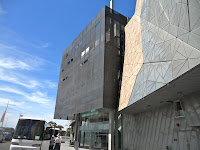January 19, Wednesday
At the risk of putting too much of a stretch on today’s title, let John explain: acrylics are the medium used by the central Australian aborigines to develop their painting skills in the 1970s, shown in an entrancing show at the National Gallery of Victoria’s Potter Gallery, and emulsions and graniti are favored food techniques of chef Ben Shewry at his Attica restaurant in Ripponlea, near Melbourne.
So we’ll begin with dinner last night at Attica. It’s about 10 minutes from Flinders Street station on the train, then a short walk in a gritty downscale Jewish neighborhood with a goodly number of Hasidim.
The room itself is small and elegant and the staff is more than sufficiently attentive to the diner’s wants. Dinners on Tuesday are what the chef comes up with in the morning, works with his staff for 50 manhours during the day and presents to the diners as his developing menu ideas. The wine cellar staff chooses the wines from the large cellar to go with the dishes.
Some of these dishes are very successful, some are passingly so. Some of the wines work wonderfully with the dishes, complementing the tastes, others...well...
We started with an excellent Sato 2010 riesling, frizzante, from Central Otago, New Zealand, south of Christchurch. This was refreshing and for those who don’t like rieslings was a welcome change from an expected sweetness. The dish it went with was a very pleasant mixture of spanner crab meat (a flat Australian waters crab with delicate taste) smoked cucumber, cucumber ice, buckwheat, and crab mustard. It did not taste contrived, in fact the flavors alloyed together retaining their identities.
The next course was chilled onion broth, looking much like a light consommé, but with a sheen of mustard oil and a flittering of wild fennel pollen. This was a light clear dish that was full of flavor and went well with the Melbourne weather yesterday of hot hot sunny 94F. The La Goya Manzanilla NV, Sanlucar de Barrameda, Spain was not a successful accompaniment. The intent was to take the nuttiness of the sherry-like manzanilla and combine it with the onion. Unfortunately the sherry was too strong and dry. But the broth was superb.
The third of the five course tasting menu was a beef tongue, with black tomato and a variety of 11 basil leaves. The tongue melted in your moth, with an almost-chili-like taste through it. It was served with shaved dried beef flakes. Now, the wine to go with this was a French style Mornington Peninsula Eldridge Estate PTG 2011. Because of appellation controls, the PTG stands for gamay and pinot noir. It was quite fresh but very full flavored. Mornington is about 25 miles south of Melbourne on the the Southern Ocean. Needless to say, this dish and accompanying wine was a hit.
The fourth taste was Bundarra Pork, slow-roasted with pear and horseradish and bitter leaves--chicory and dandelion. Ben and John both enjoyed this pig. There were two cuts, one a shoulder cooked slowly for 12 hours, which was quite fatty and the loin, which was very lean. Jane got a very fatty piece of shoulder that put her off the dish a bit, its being the same with her son, Gus. However, the pork was very tasty even with from the fatty shoulder. Bundarra describes itself as ”a small 100% free range Berkshire Pork farm on the Murray River near Barham NSW. Our Pork is produced sustainably and tastes bloody magnificent.” We agree. The accompanying wine was also a success, a Massena Barbera 30122 from Barossa Valley, South Australia. It was not the shiraz you’d expect, but more of an northern Italian wine to go with the richness of the Bundarra Pork.
Dessert, accompanied by a Charles Hours Uroulat Jurançon 2009 from Languedoc, was shaved clingstone peaches with frozen cider, raspberries and silver thyme. The thyme made the dish a wonder, giving it a new dimension. The wine was only modestly sweet and made a perfect accompinament.
So, in all it was a wonderful evening. The emulsion olive oil to go with the excellent bread was superb, as was the smoked butter. We enjoyed Chef Shewry’s kitchen. We’ll avoid discussing the cost.
Today we took the docent tour of the Tjukurrtjanu central Australian exhibit of art from the early 1970s. We learned how to look at the paintings and how to decipher the meaning of many of them at the direction of an excellent volunteer docent at the NGV.
The paintings are all top down and do not have vertical or horizontal dimensions. There are marks indicating feet, shapes indicating animals and humans, and other shapes that indicate the ideas or dreamings of the makers. The paintings are so different from anything you’ve seen before that they become overwhelming in their complexity. We loved them, but our minds are still tired from the learning about the dreamings.
The paintings were all done in a two year period 1971-1972 at a government-sponsored program that brought together a few aborigine tribes in Northern Territories. They learned to paint in acrylics what they had been doing for millenia in sand and as body paintings. The paintings are now very well-known and loaned to the NGV’s show. The are very beautiful in their intricate designs and their messages. Many of the messages, though, because they are not to be visible to the uninitiated or women, are hidden under the dots that are part of many aboriginal paintings and were developed at this time, 40 years ago.
Tonight it is a train ride to Tooronga and dinner with friends Pez and Angie and sons. Tomorrow off to Canberra.



No comments:
Post a Comment